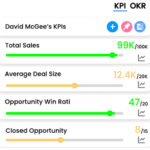Key Performance Indicators Examples

Sales Cycle Time
The Sales Cycle Time is the time period that it takes to move a lead or a sales opportunity from the initial contact to the final sale. It is used to measure the efficiency of the sales process and to identify areas where the process could be improved.
The formula for Sales Cycle Time is:
Sales Cycle Time = (Date of Sale – Date of Initial Contact)
It is calculated by measuring the amount of time between the date of initial contact with the lead or sales opportunity and the date the sale is closed. The unit of Sales Cycle Time is typically in days, weeks, or months.
For example, if the initial contact with a lead was made on January 1st and the sale was closed on February 15th, the Sales Cycle Time would be 45 days.
It’s important to track the Sales Cycle Time over time, compare it against industry benchmarks and historical data, to identify areas where the process could be improved. It’s also important to track the Sales Cycle Time by different segments, such as by different teams, products, or customers, in order to identify where the problem is and take action to reduce the Sales Cycle Time.
The Sales Cycle Time is an important metric for companies, as it allows them to identify trends in the efficiency of the sales process and to make informed decisions about process improvement and resource allocation.
It’s also important to keep in mind that the Sales Cycle Time should be aligned with the business requirements and the needs of the end-users, a short Sales Cycle Time can indicate a strong sales process, but it can also mean that the sales team is not focusing on the most qualified leads.
Measure what matters for your business with KPIs
Track business performance with real time key metrics against targets in one place without the need for multiple dashboards or reports
